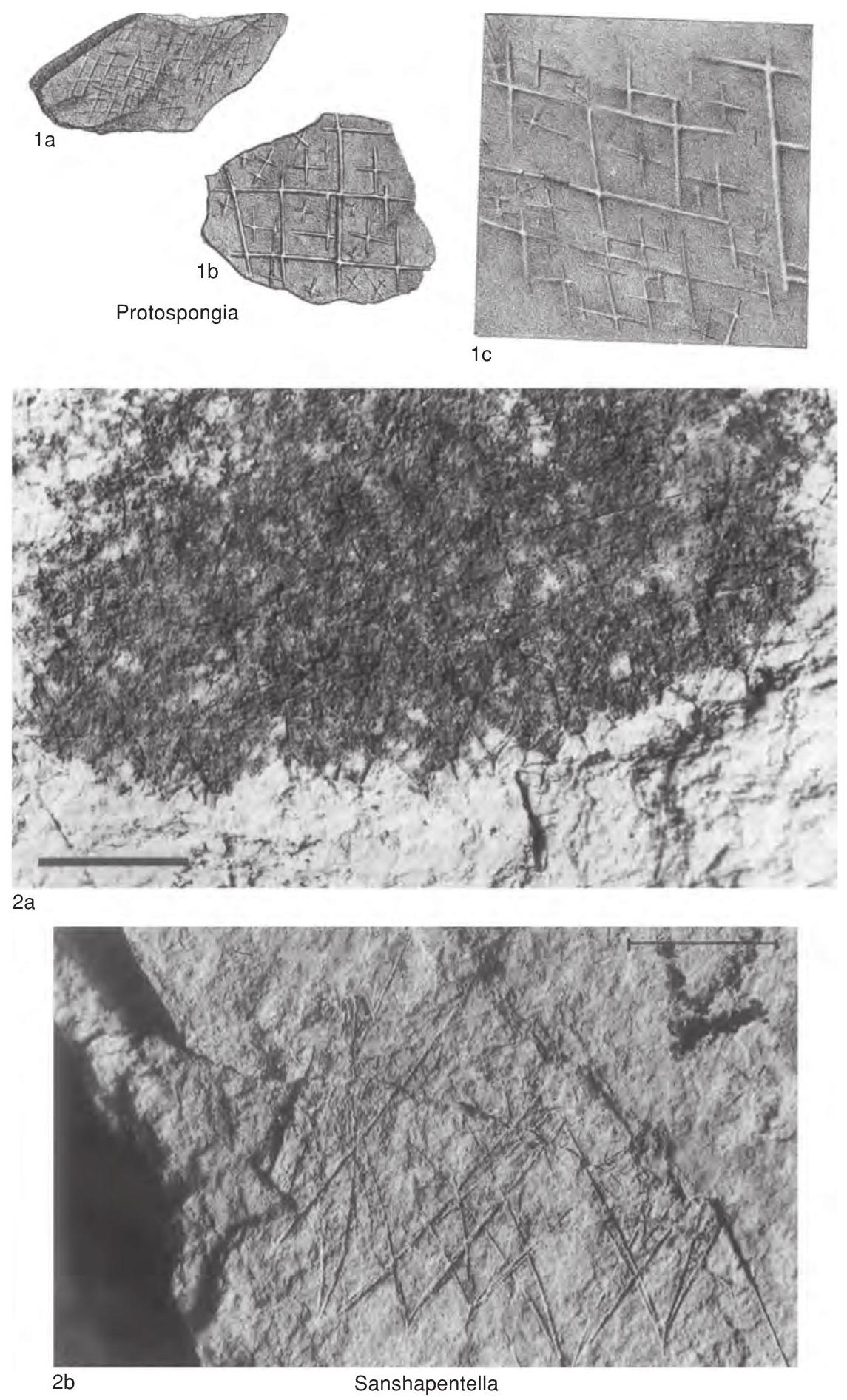Welcome to the Treatise on Invertebrate Paleontology!
Please enter a genera name to retrieve more information.

Protospongia
Classification
Phylum:
Porifera
Class:
Hexactinellida
Subclass:
Amphidiscophora
Order:
Reticulosa
Superfamily:
Protospongioidea
Family:
Protospongiidae
Formal Genus Name and Reference:
Protospongia SALTER, 1864, p. 238
Type Species:
P. fenestrata, M
Images
(Click to enlarge in a new window)
Fig. 218, 1a-c. *P. fenestrata, Menevian strata, Middle Cambrian, St. David's, southern Wales, England; a, holotype fragment with spicule impressions, X1; b, enlargement of spicules of type, BMNH X4 (Salter, 1864); c, drawing of holotype, X5 (Hinde, 1884a).
Synonyms
Geographic Distribution
China (Anhui), Lower Cambrian, Wales, Ireland, Russia, USA (Utah, Idaho), Canada (British Columbia, Quebec), Middle Cambrian, Argentina, Australia, Lower Ordovician, Australia (Victoria), Middle Ordovician, Canada (British Columbia), lower Silurian-middle Silurian, Portugal, USA (?Nevada), upper Silurian, USA (Nevada), Givetian
Age Range
Beginning Stage in Treatise Usage:
Lower Cambrian
Beginning International Stage:
Fortunian
Fraction Up In Beginning Stage:
0
Beginning Date:
538.8
Ending Stage in Treatise Usage:
Devonian (Givetian)
Ending International Stage:
Givetian
Fraction Up In Ending Stage:
100
Ending Date:
378.9
Description
Large, ovoid or vasiform sponge with osculum, thin body wall composed of stauractines arranged parallel to principal dimensions of sponge with rays gently reflexed, largest stauractines in quincuncial arrangement overlapping slightly to form primary quadrules that are subdivided into as many as six or more orders of quadrules by smaller stauractines, each about half as large as preceding order, each smaller spicule lying beneath next larger, layer of nonparallel, small rhabdodiactines may underlie all the rest, rhabdodiactine prostalia may be present over entire body and may form a coronal fringe about osculum, small number of elongate, possible rhabdodiactines may form root tuft
References
Salter, J. W. 1864. On some new fossils from the LingulaFlags of Wales. Quarterly Journal of the Geological Society of London 20:233-241, 3 fig., pl. 13.
Museum or Author Information
Classification
Phylum:
Porifera
Class:
Hexactinellida
Subclass:
Amphidiscophora
Order:
Reticulosa
Superfamily:
Protospongioidea
Family:
Protospongiidae
Formal Genus Name and Reference:
Protospongia SALTER, 1864, p. 238
Type Species:
P. fenestrata, M
Images
(Click to enlarge in a new window)
Fig. 218, 1a-c. *P. fenestrata, Menevian strata, Middle Cambrian, St. David's, southern Wales, England; a, holotype fragment with spicule impressions, X1; b, enlargement of spicules of type, BMNH X4 (Salter, 1864); c, drawing of holotype, X5 (Hinde, 1884a).
Synonyms
Geographic Distribution
China (Anhui), Lower Cambrian, Wales, Ireland, Russia, USA (Utah, Idaho), Canada (British Columbia, Quebec), Middle Cambrian, Argentina, Australia, Lower Ordovician, Australia (Victoria), Middle Ordovician, Canada (British Columbia), lower Silurian-middle Silurian, Portugal, USA (?Nevada), upper Silurian, USA (Nevada), Givetian
Age Range
Beginning Stage in Treatise Usage:
Lower Cambrian
Beginning International Stage:
Fortunian
Fraction Up In Beginning Stage:
0
Beginning Date:
538.8
Ending Stage in Treatise Usage:
Devonian (Givetian)
Ending International Stage:
Givetian
Fraction Up In Ending Stage:
100
Ending Date:
378.9
Description
Large, ovoid or vasiform sponge with osculum, thin body wall composed of stauractines arranged parallel to principal dimensions of sponge with rays gently reflexed, largest stauractines in quincuncial arrangement overlapping slightly to form primary quadrules that are subdivided into as many as six or more orders of quadrules by smaller stauractines, each about half as large as preceding order, each smaller spicule lying beneath next larger, layer of nonparallel, small rhabdodiactines may underlie all the rest, rhabdodiactine prostalia may be present over entire body and may form a coronal fringe about osculum, small number of elongate, possible rhabdodiactines may form root tuft
References
Salter, J. W. 1864. On some new fossils from the LingulaFlags of Wales. Quarterly Journal of the Geological Society of London 20:233-241, 3 fig., pl. 13.
